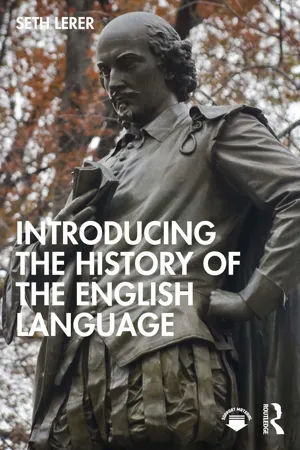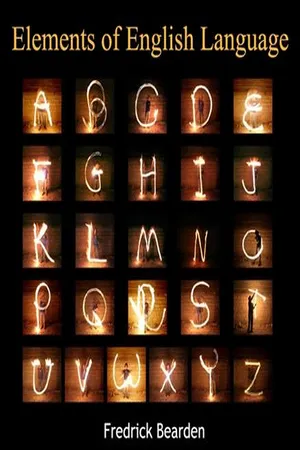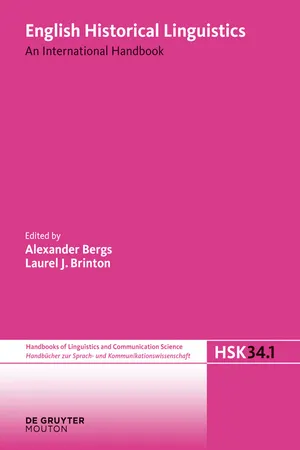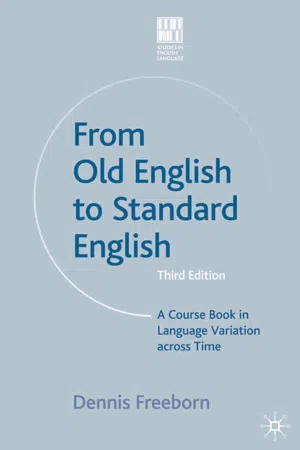Languages & Linguistics
Old English Language
Old English, also known as Anglo-Saxon, was the language spoken in England from around the 5th to the 11th century. It is a Germanic language and is the earliest form of the English language. Old English has a complex grammar and a vocabulary heavily influenced by Germanic and Norse languages. It is written in the runic alphabet and later in the Latin alphabet.
Written by Perlego with AI-assistance
Related key terms
1 of 5
9 Key excerpts on "Old English Language"
- eBook - ePub
- Seth Lerer(Author)
- 2024(Publication Date)
- Routledge(Publisher)
3 The Old English PeriodDOI: 10.4324/9781003227083-4Old English (OE) describes the Germanic vernacular spoken and written in the British Isles from roughly the middle of the fifth century until the early twelfth century. OE shared features of grammar, sounds, and vocabulary with other early Germanic languages and many modern ones. It was highly inflected, using word endings to determine the relationships among words in a sentence. Nouns had grammatical gender (masculine, feminine, and neuter); they belonged to certain groups or classes (depending on their sound histories of their roots); they were declined in a variety of cases, depending on their grammatical function; and there had to be agreement with adjectives that modified them (that is, similar endings depending on the number, case, and gender of the noun). Verbs were conjugated according to tense and number; verbs were also grouped into classes depending on their sounds and sound histories; and certain verbs formed their tenses by changing the root vowel (strong verbs, such as drink, drank, drunk) and others formed their tenses by adding a suffix (weak verbs, such as live, lived). OE had a distinctive sound (one that has been reconstructed, with reasonable accuracy, by scholars over the past three hundred years) and a distinctive way of forming letters in writing (adapting old runic letters for sounds not found in the Latin alphabet). It was the medium of prayer, scholarship, history, poetry, and philosophy for more than four hundred years.This chapter illustrates the distinctive features of OE and gives students basic reading knowledge of the language so that they may understand its place in English linguistic history and the literary imagination. We will also see how studying OE gives us access to a political and social world, to myth and religion, and to creativity and culture. OE was not a single, static language, however. Over the seven centuries of its use, it changed: new words came in from Latin and Scandinavian languages; word endings appear to have been leveled out or even lost; patterns of word order and particulars of literary style evolved. In addition, OE varied in sound and sense across the British Isles. Scholars have identified four major regional dialects by examining the spelling of words in surviving manuscripts. Old English was the language of kings and agricultural workers, poets and monks. It was a vernacular marked by nuance and variety, depending on the who, when, and where of its use. - No longer available |Learn more
- (Author)
- 2014(Publication Date)
- University Publications(Publisher)
During this early period it assimilated some aspects of the languages with which it came in contact, such as the Celtic languages and the two dialects of Old Norse from the invading Vikings, who occupied and controlled large tracts of land in northern and eastern England, which came to be known as the Danelaw. Germanic origins The most important force in shaping Old English was its Germanic heritage in its vocabulary, sentence structure and grammar, which it shared with its related languages in continental Europe. Some of these features are shared with the other West Germanic languages with which Old English is grouped, while some other features are traceable to the reconstructed Proto-Germanic language from which all Germanic languages are believed to derive. Like other Germanic languages of the period, Old English was fully inflected with five grammatical cases (nominative, accusative, genitive, dative, and instrumental, though the instrumental was very rare), which had dual forms for referring to groups of two objects (but only in the personal pronouns) in addition to the usual singular and plural forms. It also assigned gender to all nouns, including those that describe inanimate objects: for example, sēo sunne (the Sun) was feminine, while se mōna (the Moon) was masculine (cf. modern German die Sonne and der Mond ). Latin influence A large percentage of the educated and literate population of the time were competent in Latin, which was the scholarly and diplomatic lingua franca of Europe at the time. It is sometimes possible to give approximate dates for the entry of individual Latin words into Old English based on which patterns of linguistic change they have undergone. There were at least three notable periods of Latin influence. The first occurred before the ancestral Angles and Saxons left continental Europe for Britain. The second began when the Anglo-Saxons were converted to Christianity and Latin-speaking priests became widespread. - eBook - ePub
- David Graddol, Dick Leith, Joan Swann, Martin Rhys, Julia Gillen, David Graddol, Dick Leith, Joan Swann, Martin Rhys, Julia Gillen(Authors)
- 2020(Publication Date)
- Routledge(Publisher)
Englisc ('English') was first used to denote both people and language under his auspices.In the tenth century there was another revival of learning and literary activity, this time associated with the influential Benedictine monasteries. The scriptorium of the monastery at Winchester, producing texts in the West Saxon dialect, seems to have made considerable efforts to regularise spellings and this has been seen as a move in the direction of standardisation in English. (See another book in this series, Graddol et al, 2007, for further discussion of this issue).Most extant Old English manuscripts date from the late Old English period and they preserve, not only translations of learned Latin texts, but also an important body of vernacular literature in prose and poetry. Some of the poems are religious, following the example set by Caedmon, and others (such as Beowulf) stem from inherited Germanic traditions.So far we've looked at Old English: where it came from, what it was like, how certain aspects of it changed, and how the process of change might be explained. We now move on to a different period of the English language, that known as 'Middle English'.2.6 The transition to Middle EnglishWe have seen that the English language was undergoing significant change during the early part of the tenth century. In 1066 an event occurred that was to have a profound effect on this process. In that year a French-speaking dynasty from the dukedom of Normandy was installed in England. This external event has long been seen as decisive, not only for the history of England (and consequently Britain) but for the English language as well. For scholars who have viewed the history of England and English as one of unbroken progress, the Conquest has often been a milestone on the road to 'civilisation', playing a key role in the development of Modern English. But another view, perhaps more widely held, sees the events of the Conquest in terms of (an at least temporary) decline: as the wrecking of a relatively sophisticated 'native' Anglo-Saxon culture by a 'foreign' and tyrannical French one, so that the continuity of English culture was ruptured and the continued existence of the English language threatened. - No longer available |Learn more
- (Author)
- 2014(Publication Date)
- Learning Press(Publisher)
Nevertheless, about half of the most commonly used words in Modern English have Old English roots. The words be , strong and water , for example, derive from Old English; and _______________________________ WORLD TECHNOLOGIES ______________________________ many non-standard dialects such as Scots and Northumbrian English have retained many features of Old English in vocabulary and pronunciation. Old English was spoken until sometime in the 12th or 13th century. Later, English was strongly influenced by the North Germanic language Old Norse, spoken by the Norsemen who invaded and settled mainly in the north-east of England. The new and the earlier settlers spoke languages from different branches of the Germanic family; many of their lexical roots were the same or similar, although their grammars were more distinct. The Germanic language of these Old English-speaking inhabitants was influenced by contact with Norse invaders, which might have been responsible for some of the morphological simplification of Old English, including the loss of grammatical gender and explicitly marked case (with the notable exception of the pronouns). English words of Old Norse origin include anger , bag , both , hit , law , leg , same , skill , sky , take , and many others, possibly even including the pronoun they . The introduction of Christianity added another wave of Latin and some Greek words. The Old English period formally ended sometime after the Norman conquest (starting in 1066 AD), when the language was influenced to an even greater extent by the Norman-French speaking Normans. The use of Anglo-Saxon to describe a merging of Anglian and Saxon languages and cultures is a relatively modern development. - eBook - PDF
Long Story Short:
An Interactive Journey through the History of English
- Paula Rodríguez Abruñeiras, Jesús Romero Barranco(Authors)
- 2021(Publication Date)
- Publicacions de la Universitat de València(Publisher)
UNIT 3. OLD ENGLISH 3.1. EXTERNAL HISTORY AND ITS INFLUENCE ON THE LANGUAGE The mid-5 th century is usually regarded as the beginning of the OE period because it is the moment when the Angles, the Saxons, and the Jutes (and the lesser-known Frisians) settled in Britain. As a matter of fact, the word English derives from the name of one of these tribes, namely the Angles: it is made up of the noun Engle plus the suffix -ish : “The original sense of the adjective [ English ] must have been ‘of or belonging to the Angles’” (OED, s.v. English adj. (and adv.) and n., Etymology). However, the island had been inhabited for thousands of years before that (at least 50,000 years according to some sources, 250,000 in the eyes of others; see Baugh and Cable 2005: 38), and those inhabitants had their own language. Unfortunately, we do not have linguistic remains from that period, not at least until the arrival of the Celts. In all likelihood, the Celtic tribes which inhabited Britain (known as Britons ) were the first speakers of an IE language in England (see Gramley 2019, Section 2.1, and Baugh and Cable 2005: 39). After them, the Romans invaded (most of) the island taking their own language with them. Celtic and Latin were the earliest influences on OE. 3.1.1. Celtic influence Celtic tribes had been living in Britain (and in most of the European continent) for thousands of years before its written history began. In the 5 th century, five main Celtic languages were spoken there, namely Welsh, Scots Gaelic, Cumbric, Cornish, and Manx (Denison and Hogg 2006: 8). At present, Celtic languages are only spoken to some extent by minorities in France and in the Scan the following QR code to see a prank on the origin of the word England (also available at https://starkeycomics.com/2019/06/20/england-could-have-been-sexland/) Long Story Short: An Interactive Journey thorugh the History of English 47 British Isles. These are the so-called Celtic nations . - eBook - ePub
Beowulf and Other Stories
A New Introduction to Old English, Old Icelandic and Anglo-Norman Literatures
- Joe Allard, Richard North(Authors)
- 2014(Publication Date)
- Routledge(Publisher)
Naturally, I am going to take the position that Old English is not only easy but also worth learning. But along the way I shall try to give you enough information about the language to allow you to come to your own conclusion. Old English is a language like other languages OK, so Old English is a language. Why am I pointing out something as obvious as that? Old English used to be universally taught as a linguistics course, in which students learned not only the language, but also learned in great detail how each of its features had descended from Germanic and Indo-European originals. People who were forced to take such courses often moan (sometimes in the Guardian or Times Literary Supplement) about the pain and boredom of the experience. Historical linguistics – the study of how languages change over time – is a lively field that a great many students find fascinating. Many find it worthwhile to know the place of English in the Germanic sub-family of languages and the place of Germanic in the enormous and ancient Indo-European language family (see Chapter 1, p. 8). Many also find it edifying to learn how and why English has changed over the centuries, if only because the language is still changing, more or less rapidly, everywhere it is spoken. But you don’t need to become a historical linguist if your purpose is to read Beowulf or The Anglo-Saxon Chronicle, any more than you need to learn the history of French to read Flaubert or navigate the Champs Elysées. One would have thought it obvious to everyone that any language can be learned without resort to historical linguistics. But no, even today there are textbooks that insist, either explicitly or implicitly, that one must study certain ‘sound changes’ in order to learn Old English - eBook - PDF
- Alexander Bergs, Laurel J. Brinton, Alexander Bergs, Laurel J. Brinton(Authors)
- 2012(Publication Date)
- De Gruyter Mouton(Publisher)
The sociolinguistic turn brought about by the Norman Conquest deprived the normative tendencies manifest in Old English of their linguistic foundation and their institutional support. The dearth of vernacular sources in early Middle English and the unregulated character of their lan-guage highlight the unique position Old English holds among the vernaculars of early medieval Europe as regards its great appreciation as well as its conscious handling and use by the intellectual elites of Anglo-Saxon England. 24 Old English: Standardization 373 Alex Bergs and Laurel Brinton 2012, Historical Linguistics of English (HSK 34.1), de Gruyter, 373 – 385 1 Introduction If William the Conqueror had not invaded England in the year 1066, standard English would have looked completely different today. Not only would the enormous French com-ponent in the English vocabulary have been considerably smaller, the standard language would in all likelihood have had its origin in a different dialect as well. Introducing the topic of “Standardisation” in the history of English, Terttu Nevalainen and Ingrid Tieken-Boon van Ostade (2006: 271) thus point to the fact that the story of Standard English is markedly discontinuous in chronological as well as in geographical terms. The standardizing process in pre-Conquest times which the above quotation al-ludes to is subsequently concretized as having “affected the West Saxon dialect, with Winchester as its main cultural centre”. While this statement can be said to be represen-tative of traditional scholarly opinion, Richard Hogg in a handbook article on “Old English Dialectology” published in the same year takes a much more radical stance by concluding “that it is doubtful that there ever existed a variety of West Saxon which could properly be described as forming a ‘Standard Old English’ ” (Hogg 2006: 402). - eBook - PDF
- Thomas Kohnen(Author)
- 2014(Publication Date)
Old English lacks the many loan words (mostly from Latin and French) which are so characteristic of the modern language. 49 The Old English vocabulary is purely Germanic, that is, it contains mostly words whose cognates we basically find in other Germanic, in particular West Germanic, languages (for example, Dutch or German). Thus, to a native speaker of German, the Old English lexicon may appear far less mysterious than to a native speaker of English. Native speakers of German may easily trace similarities between Old English words and their German counterparts. For example, Old English niman (“take”) corresponds to German nehmen, Old English weorpan (“throw”) to German werfen, Old English ræ ˉd (“advice”) to German Rat, Old English earm (“arm”) to German Arm, and so on (see also Chapter 2 on some phonological similarities between English and German). You can see from the above examples that many of the Germanic words disappeared at some stage in the history of the English language (most of them during the Middle English period). Of the estimated 30,000 recorded lexical words found in Old English 85 per cent are no longer in use. However, those Germanic words which survived belong to the core section of the vocabulary. They are words which designate fundamental concepts and which are used with a high frequency (for example, the words mann (“man”), wīf (“woman”), cild (“child”), hūs (“house”), gōd (“good”), strong (“strong”) and so on). In addition, they comprise function words like pronouns, prepositions, conjunctions, auxiliary verbs (although, as we shall see, not all function words are native Old English words). Some Germanic words that survived passed through the centuries without much change of meaning (for example, cild, hūs, gōd, strong, which were mentioned above). Others, however, show more or less significant modifications of meaning. - eBook - PDF
From Old English to Standard English
A Course Book in Language Variations Across Time
- Dennis Freeborn(Author)
- 2017(Publication Date)
- Red Globe Press(Publisher)
5 From Old English to Middle English 5.1 The evidence for linguistic change The ways in which we have identified and described features of the language in the Old English texts in Chapters 1–4 are those that we can systematically apply to any text of English. We look for: ● Changes in spelling conventions, letter forms and the alphabet used. These are our only guide in OE and ME texts to the pronunciation of the language. ● Changes in pronunciation , inferred from the written words. ● Changes in word structure , suffixes (inflections) and prefixes. ● Changes in the grammar and word order. ● Changes in the word-stock or vocabulary – new words appear, old ones are no longer used. We call the language from about 1150 to 1450 Middle English (ME), because from our point of view in time it comes between the periods of Old and Modern English. The evidence for change and development in ME, before the first printing press was set up by William Caxton in 1476, lies in written manuscripts, just as for OE. Every copy of a book, letter, will or charter had to be written out by hand, but only a few of the existing manuscripts in ME are originals, in the hand of their author. Many copies of a popular book like Chaucer’s Canterbury Tales , for example, have survived, though Chaucer’s original manuscripts have been lost. On the other hand, other works are known through a single surviving copy only. As a result of the social and political upheaval caused by the Norman Conquest (see section 5.2, following), the West Saxon standard system of spelling and punctuation was in time no longer used. Writers used spellings that tended to match the pronunciation of their spoken dialect. Scribes often changed the spelling of words they were copying to match their own dialectal pronunciation. After several copies, the writing might contain a mixture of different dialectal forms.
Index pages curate the most relevant extracts from our library of academic textbooks. They’ve been created using an in-house natural language model (NLM), each adding context and meaning to key research topics.








